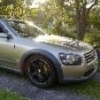M35 leaning out after fuel pump rewire
Announcements
-
Similar Content
-
Latest Posts
-
By DatsunBanana · Posted
Thanks everyone for the replies and suggestions. Got the seats out (hoping I could find some existing grommets but no such luck). By tapping and measuring etc. I could figure out where I could drill through if needed. But first I borrowed an inspection camera and managed to go through factory holes in the chassis rail and could see that the captive nut was holding steady which is why it could retighten. So it was indeed a stripped section of thread, so I applied downforce by levering the bolt head with a screwdriver and went slowly back and forth until it came out. Camera helped a lot cos I could monitor that the captive nut was holding tight. Now I just have one very seized main subframe nut to tackle 😅 -
By Dose Pipe Sutututu · Posted
BOVs do have a purpose, if you ever log pressure before and after the throttle body, you will see a spike pre throttle on lift off from a WOT condition. Enough to bend throttle blades / damage e-throttle motors or simple assist in blowing off cooler pipes. FWIW, the above on really applies to those running at least 2 bar of boost. OP shouldn't have an issue, on the other hand, here are some videos of my shit box over a decade ago with some succulent dose with the airbox on and off. That shit box is unrecognisable these days 🫠 -
I've tried all different combinations of BOVs/ no BOV and stock bypass valves over the years, on gear changes the stock bypass valve seems to get the car back on boost quicker because in part the turbos wheel speed isn't being slowed down by reversion, although they have issues holding boost much over the stock setting. Most aftermarket BOVs you can adjust the spring, tighter will make it open later and close sooner, but in my experience it'll cause a bit of flutter at low load/rpm anyway. I've also got some input into this whole no bov causing turbo wear, never had an issue on any on my turbos HOWEVER, I got my R33 GTST with 200k kms on it, with from what I can see still has the original turbo, no lateral shaft play but has about 4-5mm of play in and out which to me seems like a worn thrust bearing from years (100-150k kms?) of turbo flutter running no bov, so maybe there is some truth to it in the long run. But that'll never stop me loving the Stutututu while I have the car. OP just wants to know if he can run a atmo vented BOV with no major issues and the answer is YES, plenty of people do it, there's no harm in installing it and seeing how it runs before spending $$$ on an aftermarket ecu, last time I bought a Nistune it was $2400 for install and a tune , unsure of todays prices but you get me. Crazy money to spend just to fix the minor inconvenience of stalling that can be overcome by letting the revs come down to near idle before putting the clutch in or a little bit of throttle to avoid it. You're better off leaving the ecu and tune for after a bigger turbo/injectors have been installed to take full advantage of the tune and get your moneys worth. Let OP have his Whoosh sound without trying to break his bank haha
-
I see you missed the rest of the conversation where they have benefits, but nothing to do with avoiding breaking turbos, which is what the aftermarket BOV made all the fan boys, tuners, and modders believe was the only purpose for them...
-
But they do so for the other reasons to have a compressor bypass. It's in the name.
-






Recommended Posts
Create an account or sign in to comment
You need to be a member in order to leave a comment
Create an account
Sign up for a new account in our community. It's easy!
Register a new accountSign in
Already have an account? Sign in here.
Sign In Now